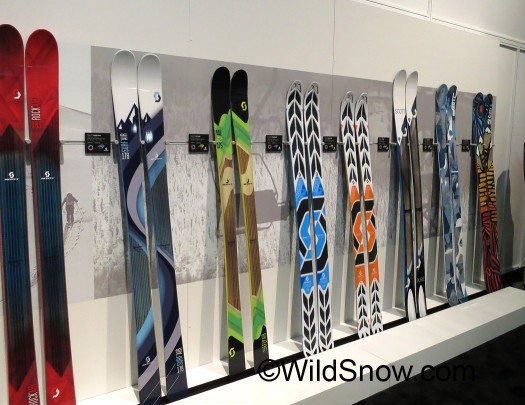
Myself (right) and Herve Maneint of Scott, talking ski boots and skis.
I’ve changed my tune a bit at Outdoor Retailer trade show. Rather than singing along with 300 other bloggers about the latest water bottle, I’m attempting to dig a little deeper. Success with that can be mixed. Like yesterday. I had one meeting that was so secret I’m not allowed to even think about it (except to say that the world of a certain avalanche safety device will soon change forever). But as compensation I got to spend quite some time with Herve Maneint, Scott Footwear Division Manager.
Subject at hand was of course the formerly Garmont boots and what they’re doing about the funky tech fittings. What is more, I got a good glimpse of Scott’s ski gear design culture.
The history of the Garmont boot tech inserts is odd. According to Herve (I thought this to be possibly apocryphal), the release resistant tech fittings that ended up in Garmont’s backcountry skiing boots were actually designed by intent, to have more resistance to release so they’d work better in tour mode; not popping out of the binding toe as easily. But the design tweak didn’t quite work, as the angle of the release resistance ended up compromising the ski-mode release as well. What’s more, the fittings ended up having the rattle and play we documented some time ago. In all, what we view as a colossal fail.
So, while the boys at Garmont basically did the ostrich thing when we brought up the fitting/insert issues, Scott is 100% acknowledging that the toe fittings don’t work in the way they or myself feel they should. Though yes, they’ll function for some retail customers who don’t mind the play and do enough release checks to chamfer off the edges of the insert for smoother release.
Solutions: What I gathered is that returned Garmont boots from retailers will be taken out of the pipeline. Some boots used as demos and samples will receive machining of the inserts so they’ll have proper release function, but there will not be a customer return and get your boots fixed type of situation. According to Herve, it’s simply too involved and expensive to run their specially built milling machine on hundreds of pairs of boots. Meanwhile, Scott seems to know how inserts should function, and Herve says they’re looking for a good manufacturer, either a factory in Taiwan or in Italy. All boots manufactured by Scott that go into retail next fall will have the new inserts. He said they might have samples of the new inserts by March or April this year, and we could possibly have some at WildSnow HQ to evaluate by then.
Main thing: Herve lives in Chamonix and his product testing involves both himself ski touring, as well as using a test team of some truly badass extreme skiers and guides. While some of those guys don’t give a rip how their bindings release (if ever), overall that culture knows how a tech binding and boot system should function, so I’m fairly confident we’ll see some exemplary product from Scott.
As for Cosmos and Celeste boots (and perhaps other formerly Garmont models), let me repeat again that other than the fubar fittings these boys and girls are state-of-art AT footwear. When you’re shopping for boots next fall, give them a look as their combination of weight savings and stiffness is impressive, and they of course have a different last than other brands so you might get a better fit. Indeed, with the resources of Scott behind doing improvements, Scott could quickly fly as a major performer in the AT boot circus (and a circus it will be, trust me, every ski boot company out there seems to suddenly be entering the ring).
Herve was also kind enough to walk me through their ski line for a few minutes. With Chamonix as a test bed, his ski mountaineering designs trend to performance on steeper hard snow, while tweaked to be fun in powder as well. He’s adamant about too much rocker in a ski being “stupid, stupid” (said with a French accent). Why? Because they work against you when you’re dealing with dangerous steep hard conditions. I’d agree with that, and offer that the days of one ski that does everything perfectly are still far in the future. A bunch of rocker can be fun — but.
In terms of specific Scott ski models, I’ll not drone on with a complete overview. Rather, the planks towards the middle of the photo with the little triangular graphics are the attention grabbers. They’re full carbon with a light wood core. Not as lightweight as some of the other carbon offerings out there, but presumably offering an awesome performance/weight ratio. They’re specific ski mountaineering skis, with a small amount of rocker, but again designed so you can get down some hairball pitch in Cham without taking your last ride. I particularly liked the “Powd’Air” model, with a 98 waist it’s in that realm where a true touring ski should be, with a bit of rocker but not too much. Scott’s skis are made in Austria, by Fisher. That’s a good thing as well. Austrians tend to make decent planks, at least when they get done skiing and eating St Johannes wurstel.
WildSnow.com publisher emeritus and founder Lou (Louis Dawson) has a 50+ years career in climbing, backcountry skiing and ski mountaineering. He was the first person in history to ski down all 54 Colorado 14,000-foot peaks, has authored numerous books about about backcountry skiing, and has skied from the summit of Denali in Alaska, North America’s highest mountain.

